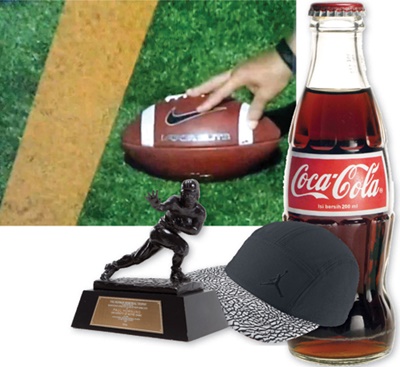Everyone knows the tremendous financial value of brands like the Nike swoosh (valued at more than $14 billion by a recent survey) and the Adidas brand (valued at more than $6 billion in the same survey). But beyond these traditional brands, comprising names and logos, are a variety of other symbols waiting for marketers to create and nurture, which will increase the value of the products with which they are used.
Brands translate to trademarks in legal parlance, and a trademark can be anything as long as it designates a particular source to consumers. For example, the Heisman Trophy is a trademark because viewers recognize it as coming from one source, even if they cannot identify that source. Other product shapes are similarly famous and also protected as trademarks — for example, the Coca-Cola bottle. That iconic shape undoubtedly is worth millions, if not billions.
Stranger things have been claimed as trademarks. One company got a federal trademark registration (since canceled) for the yellow line designating a first down in televised football games. The sound of the NBC chimes is a federally registered trademark. Colors have also been registered. The trustees of the University of Alabama have registered crimson and white as used on football uniforms. There are even federal trademark registrations for goats munching grass on the roof of a restaurant and for a piña colada-scented ukulele. The options are endless.
 |
The yellow first-down line was once a protected trademark. Jordan Brand hopes its “elephant print” becomes as recognizable a trademark as Coke’s bottle and the Heisman.
Photo by: GETTY IMAGES (Heisman)
|
The value of these trademarks derives from the fact that the owner gets the exclusive use of them. Companies therefore need to spend some time and effort making sure their use remains exclusive. Federal registration helps here. A federal trademark registration is the government’s stamp of approval that the registered trademark actually is a trademark, and that the registrant owns it.
Nontraditional trademarks take more care and feeding than the average brand. But their potential value to the company probably warrants it. A shape, for example, cannot be registered as a trademark unless its owner can show that consumers have come to recognize it as indicating a particular source. The legal term here is “secondary meaning.” Evidence of significant sales, substantial advertising, long use and frequent media mentions helps establish secondary meaning. Proper advertising can seal a product feature’s trademark status, but improper advertising can as easily torpedo it. Advertising alerting customers to look for a particular color or shape can establish trademark rights, but if your advertising advises customers of the utilitarian advantages of a product feature, you probably will not be able to claim that feature as a trademark.
Nike’s recent registration for a design sometimes called the “elephant print” that appears on its Jordan Brand products is an exemplar for showing secondary meaning. Nike submitted about a dozen media articles calling out the design, along with claims of $150 million and 4.5 million units in sales. Such a significant showing is not always necessary, but it is instructive.
Of course, when a shape is new, evidence of secondary meaning will be unavailable. Under some circumstances, the U.S. Patent and Trademark Office may let an applicant for registration of a new mark reserve it until after he starts using the mark or can show secondary meaning in it. Other protection options may be available, like copyright registrations and design patents. Ultimately, it is likely worthwhile to add trademark protection to these other options, since, unlike other types of protection, trademark protection does not expire.
A shape cannot be protected if it is functional, meaning that without it the product won’t work, or with it, the product can be made cheaper or better. The yellow first-down line mentioned above was canceled for just this reason. Sportvision, the owner of the registration, filed a lawsuit against a competitor, Sportsmedia Technology Corp., alleging that Sportsmedia’s use of a yellow line in broadcasts infringed the mark. The court found for Sportsmedia, stating that ESPN had picked the color yellow as one of only a few colors that would show up against a green football field with white lines. Therefore the yellow line was functional because it was one of only a few acceptable choices, and one company could not monopolize it. There are some similar, but perhaps less defensible cases illustrating functionality. A court found the green of John Deere farm equipment to be functional because farmers wanted their “equipment to match.” Another court found that the black color of outboard motors was functional in part because it decreased the apparent size of the motor (does this motor make my boat look fat?).
Many companies that own a patent for a product feature fall in to the trap of trying to continue exclusive use of the feature after the patent expires by claiming that the same feature is protected by trademark law. However, the patent itself probably establishes that the feature is functional, and therefore can’t be a trademark.
These stories might make you think that trying to get trademark rights for anything other than a name or logo is not worth the effort. And indeed, there are challenges. But many cases reflect either overreaching or poor planning on the part of the would-be trademark owner.
As with most everything else, the key to nontraditional trademark protection is to plan ahead and consider the protection at the time that a product is developed. If an extra source-differentiating feature, like a color or a fanciful shape, can be added to the product upon its introduction, that feature will continue to be a valuable trademark even after any patent has expired. Moreover, like many companies, yours may already have developed trademarks that now can and should be federally protected. For example, Wilson Sporting Goods filed an application in 2005 for its trademark red color for tennis equipment bags (No. 3155678), which it had been using since 1974. Your company too probably already owns valuable trademarks that you can now federally protect.
Janet Marvel (jmarvel@pattishall.com) is a partner at Pattishall, McAuliffe, Newbury, Hilliard & Geraldson in Chicago.





